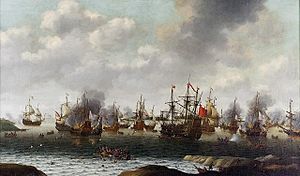Anglo-Dutch Wars facts for kids
Quick facts for kids Anglo-Dutch Wars |
|||||||
|---|---|---|---|---|---|---|---|
 Dutch attack on the Medway during the Second Anglo-Dutch War by Pieter Cornelisz van Soest, c. 1667. |
|||||||
|
|||||||
| Belligerents | |||||||
| Commanders and leaders | |||||||
| Strength | |||||||
| Dutch Republic 600 warships 1,500 Marines 50 soldiers Denmark–Norway Fortress, 250 soldiers |
England 650 warships 300 soldiers France 60 ships |
||||||
| Casualties and losses | |||||||
| Dutch Republic 56 warships lost 20 warships captured 10,150 dead 20,000 wounded 2,500 captured Denmark–Norway 8 dead 10 civilians killed |
England 40 warships lost 18 warships captured 13,310 dead 25,000 wounded 2,000 captured France 400 killed |
||||||
The Anglo-Dutch Wars were a series of important wars. They happened between England (and later Great Britain) and the Dutch Republic. These wars took place in the 1600s and 1700s. The main reason for these fights was control over valuable trade routes on the seas. Most of the battles were fought by the powerful navies of both countries.
Contents
Why England and the Dutch Fought
England and the Dutch Republic were both strong trading nations. They both wanted to control the most important trade routes around the world. This competition often led to disagreements and eventually to war. The wars were mostly about who would be the most powerful country at sea.
The First Anglo-Dutch War (1652–1654)
The first war happened when England was going through a big change. This period was called the Interregnum. It was a time when England did not have a king or queen. The war was fought between the navies of England and the Dutch Republic. Most of the fighting took place in the English Channel and the North Sea. This war ended with England gaining more control over these seas. England also got a special right to trade with its own colonies.
The Second and Third Wars (1665–1674)
The second war (1665–1667) and the third war (1672–1674) happened after England got its monarchy back. This was known as the English Restoration. England tried again to stop the Dutch from controlling most of the world's trade. Most of the battles in these wars were in the North Sea. In the third war, England fought alongside France. Even with France's help, the Dutch won both of these wars. These victories showed that the Dutch Republic was still the strongest sea power in the 1600s.
The Fourth Anglo-Dutch War (1780–1784)
The fourth war took place much later, after England and Scotland joined to form Great Britain. This war mainly started because Great Britain did not like the Dutch trading with the United States. This trade happened during the American Revolutionary War. The war ended with a peace agreement called the Treaty of Paris (1784). This war was a very big loss for the Dutch. They lost parts of their Dutch Empire.
Related pages
Images for kids
-
Dutch factory at Ambon, early to mid-17th century
-
The Battle of Leghorn, 4 March 1653
-
The Battle of Scheveningen, 10 August 1653
-
The Second Day of the Four Day Battle of 1666, by Willem van de Velde
-
The Battle of Solebay, 7 June 1672
-
The capture of Sint Eustatius by the British fleet in 1781. The island is sacked by the British.
See also
 In Spanish: Guerras anglo-neerlandesas para niños
In Spanish: Guerras anglo-neerlandesas para niños






